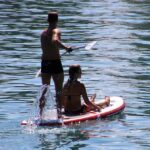Stand Up Paddleboarding (SUP) is a fun and exhilarating activity that people of all ages and skill levels can enjoy. Whether you’re looking for a workout, a relaxing day on the water, or a new way to explore the great outdoors, SUP has something for everyone. In this guide, we’ll teach you the basics of how to SUP in just 5 minutes.
Learn to SUP in 5 minutes – Step by Step Guide
Step 1: Board Handling
The first step in learning how to SUP is board handling. To start, place your board in the water and hold onto the rails (the edges of the board). Position yourself so that you’re kneeling in the center of the board with your feet facing forward. Once you’re comfortable, stand up slowly, keeping your knees bent and your weight centered over the middle of the board. This will help you maintain your balance.
Step 2: Paddle Handling
Next, you’ll need to learn how to handle your paddle. Hold the paddle with both hands, ensuring your hands are shoulder-width apart.
The blade of the paddle should be facing away from you.
To begin paddling, dip the paddle’s blade into the water and pull it towards you, keeping your arms straight. Once the blade reaches your feet, lift it from the water and repeat on the other side.
Step 3: Finding Your Balance
Finding your balance on a SUP board can take practice. The key is to keep your feet shoulder-width apart, and your knees slightly bent. Keep your weight centered over the middle of the board, and avoid leaning too far forward or backward.
It’s also essential to focus on the horizon rather than looking down at your feet or the board.
Step 4: Steering Your Board
To steer your board:
- Use your paddle as a rudder.
- If you want to turn left, paddle on the right side of the board.
- If you’re going to turn right, paddle on the left side of the board. You can also use your feet to shift your weight and help steer the board.
Step 5: Safety First
Learning to swim is essential before you start paddleboarding. Paddleboarding takes place on the water, and even if you’re wearing a PFD, being able to swim will help you feel more confident and safe in the water. Also, please always use the buddy system when paddleboarding, especially if you’re a beginner. Having someone with you on the water can help in an emergency or if you need assistance.
Another crucial safety tip is to connect your leg to the leash. The leash is a vital piece of equipment that always keeps you connected to the board. If you fall off the board, the leash ensures that the board stays within reach, and you can quickly get back on. Please make sure the leash is securely fastened to your ankle or calf so you don’t lose your board in case of a fall.
Learning how to SUP can be a fun and rewarding experience. Following these simple steps, you can master the basics in just 5 minutes. Remember to prioritize safety, practice regularly, and, most importantly, have fun!




